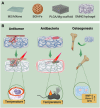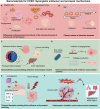Nanomaterials for Combating Cancer while Safeguarding Organs: Safe and Effective Integrative Tumor Therapy
- PMID: 40510844
- PMCID: PMC12159416
- DOI: 10.34133/bmr.0165
Nanomaterials for Combating Cancer while Safeguarding Organs: Safe and Effective Integrative Tumor Therapy
Abstract
Cancer remains a leading cause of mortality globally. Combating cancer while safeguarding organs (CCSO) has emerged as a specialized field that employs a multifaceted approach to cancer management. Postsurgery solid tumors face issues such as recurrence and organ dysfunction due to residual cancer, resection, inflammation, and infections. Adjuvant and preventive treatments may also impair organ function, adding to treatment challenges. This review delineates the multifaceted landscape of multidimensional nanomaterials, spanning from 0-dimensional nanoparticles to 3-dimensional scaffolds, and their collaborative roles in concurrent cancer management and organ protection. We underscore the importance of nanomaterial synthesis, functionalization, and responsive release mechanisms in the tumor and organ microenvironments. A comprehensive analysis of nanomaterial applications in integrated cancer management, including melanoma, osteosarcoma, breast cancer, liver cancer, pancreatic cancer, and gastric cancer, is presented, highlighting their potential to overcome therapeutic challenges. The discourse also addresses the obstacles and future directions for nanomaterials for CCSO, offering valuable insights for advancing cancer management and organ protection. This review aims to enhance the comprehension and progress of nanomaterials for CCSO, fostering the development of more effective cancer management modalities.
Copyright © 2025 Keqin Ji et al.
Conflict of interest statement
Competing interests: The authors declare that they have no competing interests.
Figures





Similar articles
-
Copper and Copper-Based Nanoparticles in Medicine-Perspectives and Challenges.Molecules. 2023 Sep 18;28(18):6687. doi: 10.3390/molecules28186687. Molecules. 2023. PMID: 37764463 Free PMC article. Review.
-
Nanomaterial-Based Strategies to Combat Antibiotic Resistance: Mechanisms and Applications.Antibiotics (Basel). 2025 Feb 18;14(2):207. doi: 10.3390/antibiotics14020207. Antibiotics (Basel). 2025. PMID: 40001450 Free PMC article. Review.
-
Advancing Cancer Treatment: Innovative Materials in PDT and Diagnostic Integration.Int J Nanomedicine. 2025 May 31;20:7037-7060. doi: 10.2147/IJN.S514937. eCollection 2025. Int J Nanomedicine. 2025. PMID: 40470109 Free PMC article. Review.
-
Gastric Resection for Malignancy (Gastrectomy).2024 May 6. In: StatPearls [Internet]. Treasure Island (FL): StatPearls Publishing; 2025 Jan–. 2024 May 6. In: StatPearls [Internet]. Treasure Island (FL): StatPearls Publishing; 2025 Jan–. PMID: 32809595 Free Books & Documents.
-
Advancing Nanomedicine Through Electron Microscopy: Insights Into Nanoparticle Cellular Interactions and Biomedical Applications.Int J Nanomedicine. 2025 Mar 8;20:2847-2878. doi: 10.2147/IJN.S500978. eCollection 2025. Int J Nanomedicine. 2025. PMID: 40078651 Free PMC article. Review.
References
-
- Sung H, Ferlay J, Siegel RL, Laversanne M, Soerjomataram I, Jemal A, Bray F. Global cancer statistics 2020: GLOBOCAN estimates of incidence and mortality worldwide for 36 cancers in 185 countries. CA Cancer J Clin. 2021;71(3):209–249. - PubMed
-
- Yang Z, Fan D. Multidisciplinary team to holistic integrative medicine. Explor Res Hypothesis Med. 2020;5(4):139–140.
-
- Curti BD, Faries MB. Recent advances in the treatment of melanoma. N Engl J Med. 2021;384(23):2229–2240. - PubMed
Publication types
LinkOut - more resources
Full Text Sources

